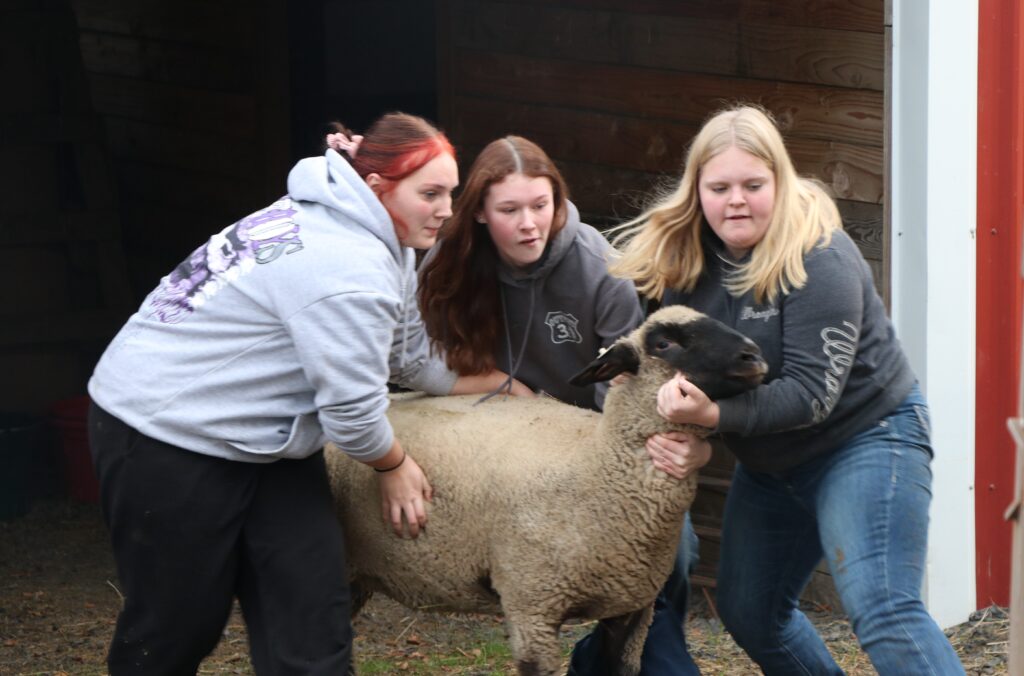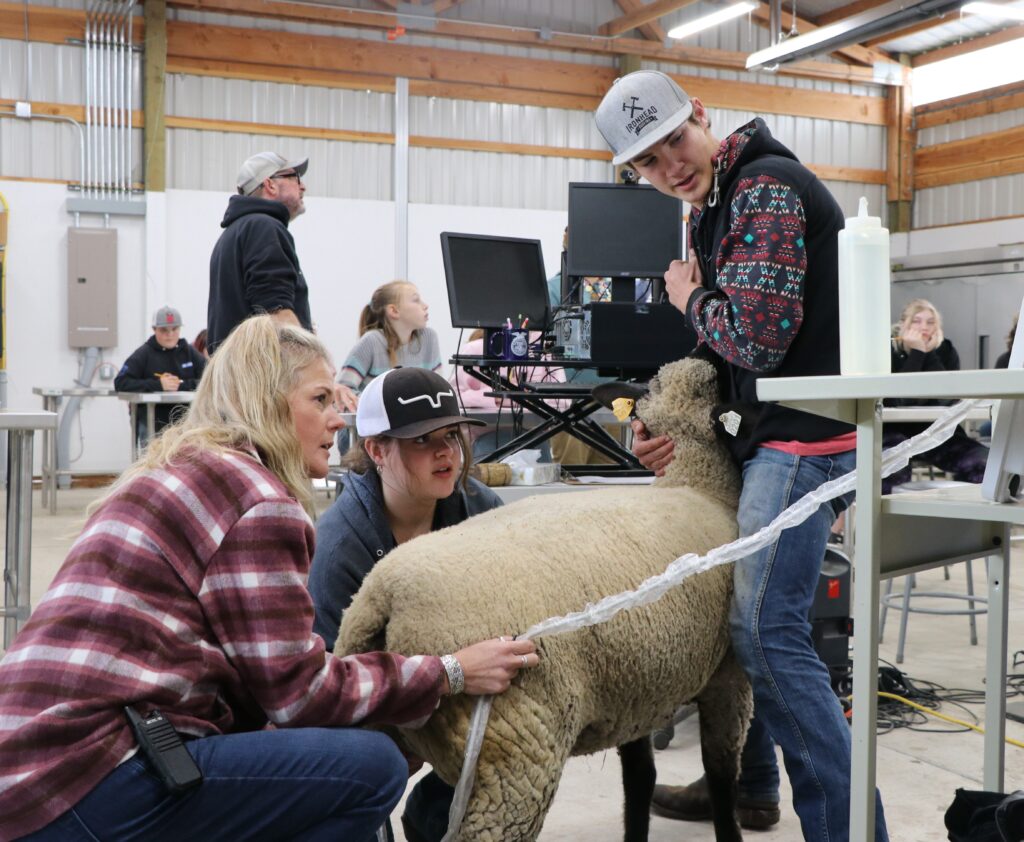
Lebanon High School senior McKenna Reynolds (from left), junior Skylar Doyle and junior Macy Rose wrangle a pregnant ewe into a trailer to take it for an ultrasound at the Lebanon Community School District land lab. (Photo by Jake Arnold)
On a crisp fall morning, Paige Needham performed an ultrasound on a ewe while middle schoolers at nearby tables watched the images on a video screen.
Needham, a high school senior, is the animal health manager for the Lebanon Community School District’s land lab. She makes sure animals have the medications, nutrition and care they need. Needham plans to become a veterinarian. It’s an ambitious arc for a young woman who said she would have dropped out of school if not for the land lab.
“I didn’t see a reason for being in school,” she said. “Being here makes me want to do more.”
Land labs are areas set aside for biological studies. Lebanon says its 55-acre lab is one of the West Coast’s largest. More importantly, district officials say, the lab’s career and technical education courses engage students, keeping them in school and encouraging them toward post-secondary studies or careers.
Lebanon’s land lab offers a unique environment to excite students. It houses agriculture, horticulture and construction programs on the edge of town. About one-fourth of the high school’s roughly 1,200 students spend part of the week on the land.
The district also allows students to raise their own animals such as sheep, pigs and cows on the property for agricultural programs such as FFA. Students can buy animals from the district’s breeding herds on payment plans, but they must provide feed and care.
Board Chair Tom Oliver, who grew up on the East Coast, said he was initially amazed a public school had a facility like the land lab. He appreciates the opportunity for children living in town to raise large animals. His own child raised a steer. At the same time, rural students have a chance to learn more about agriculture and animal science for their home farms, he said.
The lab is on a valuable piece of property and brings with it some extra expenses, but Oliver said there has never been a question about funding it.
“The return on investment is extremely high for that facility,” he said. Instead, district leaders talk about what else the land can be used for to offer interesting opportunities for students.
The property is mostly pasture and timberland sloping gently up from the entrance, with a few houses and other farms in sight on its edges. The district has owned it for more than 50 years, and it has changed drastically, adding buildings and programs.
Mike Wilson, who has been teaching on the property for more than 20 years, said the only original and unchanged building from when he started is a small hay shed. He currently teaches animal science and intermediate agriculture courses.
Students in the late 1960s helped clear the property and build fences. Now it has a cluster of buildings, including barns for pigs, cows, sheep and showing animals. There are also a maintenance shop, classroom building and three greenhouses, one recently built by students.
The facility houses a small herd of registered Angus cattle, a flock of breeding sheep and a swine operation.
It also has a new veterinary science building, where Needham was performing the ultrasound. The class space has two flat screen televisions with the technology to stream class activities and large doors for moving livestock. The classroom also welcomes activities such as a floral arrangement class.

Lebanon High School senior Page Needham (center) performs an ultrasound on a ewe with the help of teacher Brenda Phearson and senior Devon Keene. (Photo by Jake Arnold)
Farther back on the property, the construction program has a classroom as well as a large shop built mostly by students. The amateur effort shows in some of the roof lines, but instructors say it was a great learning experience. The construction students these days are mostly working on building houses in Lebanon, but they meet on the land lab property.
The wooded slope behind the construction buildings shows signs of past forestry activities. In recent decades, the educational focus has shifted toward agricultural disciplines as the local economy has also shifted from timber to farming. Still, there is talk of resuming some forestry lessons.
Chad Angel, Lebanon High associate principal, said the goal is to create a career and technical education experience that is as similar to real life as possible.
Under the guidance of three full-time instructors, the students largely run the property, with managers for different buildings and animals. Brenda Phearson teaches intro to agriculture, horticulture and landscape design. She has worked at the lab for six years and said the program wouldn’t be possible without students’ taking responsibility.
She said some of the students tend to be ones who struggle in regular classrooms but “they buy into this place pretty quickly.” She said students see that they must earn the teachers’ trust if they want to take on more responsibilities.
On a recent school day, students were roaming between buildings, driving tractors, feeding animals and wrangling livestock.
“It’s like a second home,” said senior Lily Chandler, the pig crew manager. “I love coming here and being with animals.”
Superintendent Jennifer Meckley is grateful Lebanon has this kind of opportunity.
“I think it has saved kids’ lives for sure,” she said.
– Jake Arnold, OSBA
[email protected]